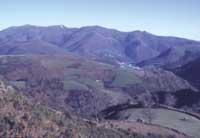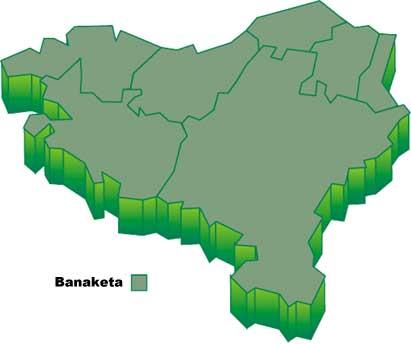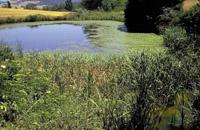The Wild Harbour, the best known of wetlands
1995/03/01 Elosegi Irurtia, Migel M. Iturria: Elhuyar aldizkaria
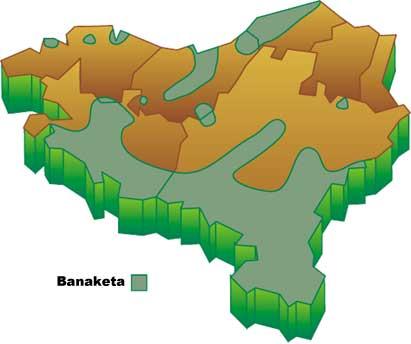
Two are the main daily activities of older people who currently reside in the villages of the Oria River Route: the care of public buildings and the care and attention of ducks in the river. The evolution of this famous river in recent years has been satisfactory. Until recently, Oria enjoyed the most polluted fame in the area, but today, despite not having crystalline waters, you can see a large number of animals, witnesses of its obvious improvement.
It is from the last four years, for example, the beautiful population of wild animals that has emerged here, and like the wild ducks of the old house, giving a complete tour of history, most of the ducks of the Oria come from those of the house, forming semi-wild and wild colonies. With the help of several people from neighboring villages, the specimens incubated in their house were released into the river, which at present have grown spectacularly.
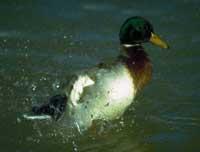
Although in this region of Gipuzkoa the wild ports are currently in full swing, in Euskal Herria have always been known. These thick ducks are the largest in the area and have a length of 58 cm. Between 850 and 1,500 grams of weight.
Noteworthy is the remarkable sexual dimorphism of wild animals, as in most duck species. The male usually has a spectacular plumage to attract the female in the form of breeding. The female, for her part, takes care of her offspring and not attract their prey, is much more modest.
The male has a very pretty dress. Highlights the intense green color of head and neck. On the neck has a narrow white ring and its bottom can be chestnut or reddish brown. Fragile grey back, fins and belly. The back is black-black and the whitish tail. In the latter it presents as ornament two curious black pens volutes up. Yellowish or green bill with orange legs.
In the case of the female, brown tones predominate and are painted with dark spots and traces. Like males, it has whitish tail and orange legs.
This species is characterized by the line of bright purple feathers decorated with green blue hues on the slopes of both sexes. In flight these colorful bands are very spectacular and are suitable to differentiate females from different species that can be easily confused.
These beautiful analogies appear closely attached to wet media. In addition to the ponds of the parks of fecal villages and capitals, we can see anywhere the size of lakes, reservoirs, rivers rich in burrows and, in general, anywhere with waters. In these places you can see couples or groups.
As for food, the wild duck is mainly herbivore. He usually eats grass, seeds, crops, stems and fruits without giving up the many invertebrates he can find. It is curious the behavior of this animal when it is fed in the water. Turn the body forward by placing it vertically, and at sight only the bottom remains, submerging the head and neck to save the underwater food. After spending the day in the water or in the surroundings, at dusk, from the humid zone, he goes to the meadows and fields of cultivation in search of food.
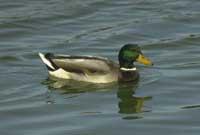
The nest is usually near the water, in the undergrowth of the riverbank or reservoir, and occasionally in some tree or moat. For the construction of the nest feathers, herbs, rams and different materials such as paper, plastic, etc. are used.
After copulating in the water, the setting occurs between March and July. This magnificent player can lay between 6 and 13 57 mm cream or vegetable eggs. After 26-29 days, the little dogs, who are nidiéfugos, are ready to feed themselves without help and follow their mother in the water, although they do not know how to fly. 50-60 days after and after many exercises, you will be able to fly.
The wild duck fin is also fast and powerful like ducks. It shows a special silk, with the neck fully stretched and the wings very fast, which normally stays in the water, leaving a long footprint when braking with its flat legs.
Once the year is over, they begin to grow. Although it has been proven that some specimens can survive for years, the average is 2 years and 87% of the population of the Iberian Peninsula is composed of ducks under 3 years. It is estimated that half of the ducks born die in winter.
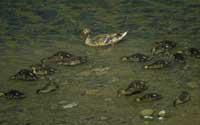
The wild duck is the most abundant duck in Europe. After its breeding throughout the continent, this partial migrant, descending north, is located in the middle and south of Europe. Weather conditions worsen and with snow storms there will be numerous wild animations in these temperate regions.
In Euskal Herria, therefore, it is very abundant in autumn and winter, although those who are raised there are not so much. There may be pairs in all countries, such as Vitoria-Gasteiz reservoirs, Navarre lagoons and rivers such as the Ebro, Zadorra, Ega, Arga or Aragon, which are common nesting sites.
In relation to what was said at the beginning of the article on the elderly, there is something I would like to mention. In places that are lucky enough to house in the village and around these animals, the elderly, mothers and babies already mentioned and all kinds of people gather every day. People come to eat, count and see ducks with bread and vegetables. However, these people are proud to have these beautiful birds in their village and appreciate them wholeheartedly.
Therefore, the conservation of the species will not be complicated, and if any of the mistakes cause damage to these animals, people get angry and ask the culprit for compensation. This is important, since the protection of the natives for the conservation of any species is always one of the greatest advances.
Species: Anas platyrhynchos Family: analogous Order: anseriformes Class: birds |

Gai honi buruzko eduki gehiago
Elhuyarrek garatutako teknologia




